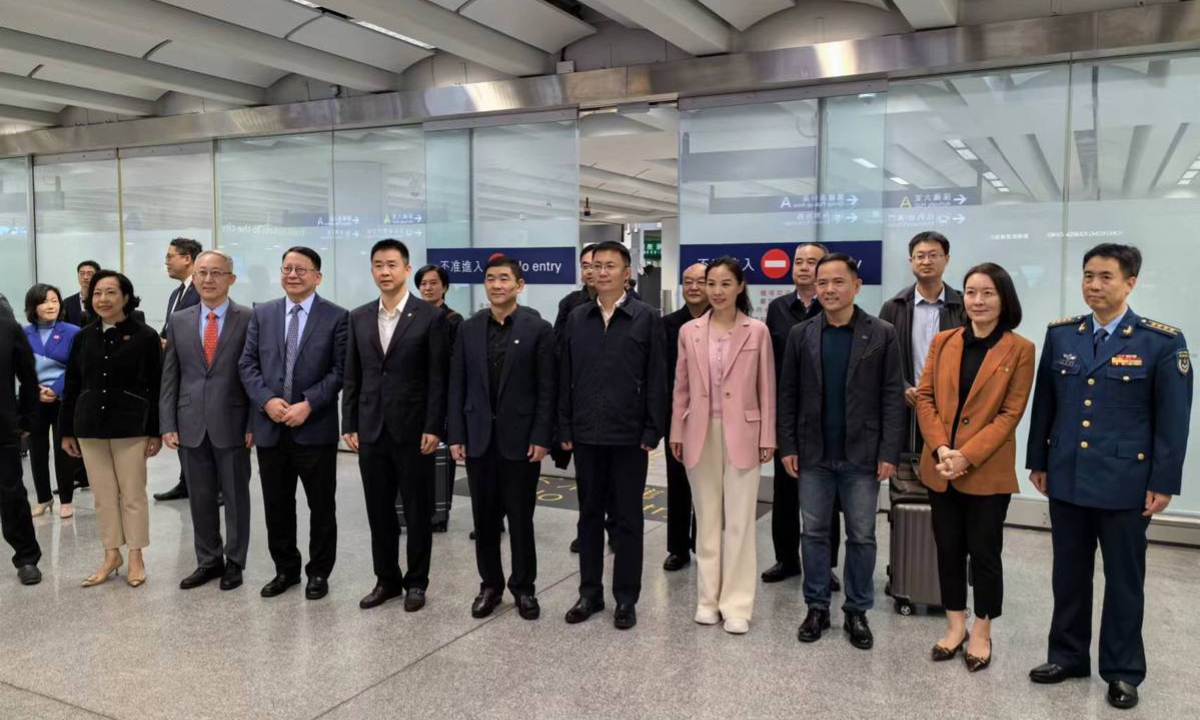
A delegation of China’s manned space engineering project pays a six-day visit to Hong Kong and Macao special administrative regions from November 28 through December 3, 2023. Photo: CCTV
A delegation of China’s manned space engineering project is paying a six-day visit to Hong Kong and Macao special administrative regions from Tuesday through Sunday, the China Manned Space Engineering Office (CMSEO) announced on Tuesday.
It has been 11 years since the manned space engineering project last time organized a delegation to visit Hong Kong and Macao in 2012 after the successful completion of the manned space docking mission by Shenzhou-9 spacecraft and Tiangong-1 lab module. It is also the first exchange and interaction with Hong Kong and Macao since the project entered the era of space station.
At the invitation of the governments of Hong Kong Special Administrative Region (HKSAR) and Macao Special Administrative Region (SAR), the delegation made up of a total of 17 experts in the field of manned space engineering systems, including four Chinese taikonauts such as Liu Boming and Wang Yaping, will meet with related departments in the special administrative regions.
Taikonauts from Chinese mainland have also visited Hong Kong and Macao in the past. The first visit occurred in 2003 when Yang Liwei, China’s first astronaut in space, spent six days in Hong Kong. Subsequently, taikonauts from the Shenzhou-6, Shenzhou-7, and Shenzhou-9 missions also visited Hong Kong and Macao.
During this visit, the delegation will attend a media briefing organized by the HKSAR government to outline the latest development of China's manned space projects and take questions from the press, attend the opening ceremony of the “China Manned Space Exhibition,” engage in discussions and exchanges with the science and education sectors in Hong Kong and Macao and participate in a special conference on manned space projects in Macao, according to a statement from the CMSEO.
Chief Executive of HKSAR John Lee extended his warm welcome to the delegation, and thanked the Central People’s Government for the arrangements of the four-day visit in Hong Kong during a press briefing on Tuesday, according to a statement from the HKSAR government.
Lee said that the China Manned Space Program has made extraordinary achievements over the past three decades. “It has made history by realizing the Chinese nation’s millennium-long dream of flying to the stars, of which we as Chinese are all profoundly proud. Through the delegation's visit, Hong Kong people can share the nation’s pride in China’s manned space development from close range, and develop a deeper understanding of the country’s developments in aerospace technologies. The visit exemplifies the affection and support of the Central People’s Government for the Hong Kong Special Administrative Region,” Lee said.
According to Lee, the delegation’s visit to Hong Kong is significant in three ways. First of all, it reflects the significant progress made by the country in aerospace science and technology which makes Hong Kong people feel proud, Hong Kong’s media outlet Orange News reported on Tuesday.
According to Lee, whenever there is a live broadcast of the manned spacecrafts, Hong Kong’s television stations will broadcast it. Hong Kong residents feel proud of the Taikonauts and the entire manned space team by watching launch events.
The visit also reflects the importance the nation attaches to the youth of Hong Kong. During their time in Hong Kong, the delegation will share insights into the development process and the latest updates in China’s aerospace endeavors through various activities and youth exchanges, including interactions with students and teachers from primary and secondary schools, and colleges. This serves to showcase the nation’s commitment to the future development of Hong Kong’s youth.
Thirdly, the visit also reflects the great importance and recognition of the central government for Hong Kong’s scientific and technological community, Lee said, noting that the delegation will also exchange views with representatives from Hong Kong’s innovation and research community.
According to Lee, local university research teams in Hong Kong have actively participated in national aerospace projects. For example, the Hong Kong Polytechnic University developed equipment to assist Chang’e-5 in lunar sample collection and provided support for Tianwen-1 Mars probe. In May of this year, The Chinese University of Hong Kong’s soybean research project soared into space with the launches of Tianzhou-6 spacecraft and Shenzhou-16 manned spaceship. Last year, China announced the initiation of astronaut selection and the selection of payload experts in Hong Kong and Macao.
According to Lee, while the country’s national aerospace industry is developing rapidly, the HKSAR government supports the local universities in participating in the national aerospace and other scientific and technological projects, contributing to the nation’s goal of becoming a technological powerhouse.
Aerospace technology is one of the industries prioritized by the HKSAR government , and the Advanced Manufacturing Centre (AMC) in Tseung Kwan O Industrial Estate already hosts enterprises involved in satellite production with local production lines in place.
Global Times




